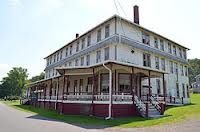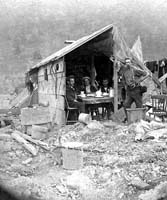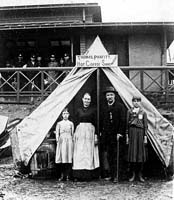Through out history there are many events that are remembered, taught in classes and learned from by a country. One of those events was the catastrophic Johnstown Flood of 1889.
On May 31st 1889 the South Fork Dam collapsed killing over 2,000 people. While no one disagrees this was a horrific tragedy, there was much controversy over whether or not it was an avoidable tragedy. No matter how the surviving townspeople of Johnstown felt, a jury agreed it was an act of ‘province”.
Background
Just outside of Pittsburgh P.A., nestled into a the valley between the Little Conemaugh River and the Stony Creek River was the booming town of Johnstown, home to 10,000 residents with an additional 20,00 living in the outskirts. This was one of many towns in that era that was supported by the steel mill industry. Many of the residents felt as though life would always be good as long as the mills ran. Since Johnstown was built in a floodplain the residents felt they could handle any flood that plagued their town, after all minor floods happened all the time. It became common place for residents to move their furniture to higher levels of their homes to avoid water damage from these floods. In 1840 the largest earth dam, a dam constructed without man-made materials such as steel, was built 14 miles away from Johnstown as part of the vast canal system. This dam created the man-made lake of Conemaugh which was used for recreational purposes by the affluent members of the South Fork Fishing and Hunting club. Some of the more well known members of the club were Andrew Carnegie, Henry Clay Frick , Andrew W. Mellon and many more.
South Forks Fishing and Hunting Club
Once the canal systems were no longer used due to the introduction of railroads, the South Fork Dam became somewhat ignored and neglected. It was, and possibly still is, believed by many, that the South Forks Hunting and Fishing Club should have looked after the dam more carefully since they owned not only the dam but also the reservoir they later renamed as Lake Conemaugh. The Club did make some repairs throughout their ownership, but they also made modification that made the dam more dangerous. One dangerous modification was installing fish screens in order to keep the more expensive “game” to stay within the lake and not escape down the river. These screen prevented debris from leaving the spillways. The other major harmful modification was lowering the dam in order for two carriages to cross it at the same time. This meant the dam was only 4 feet higher than the spillway. In these processes the drainage pipes were removed, but were never replaced.
The Flood
On May 31st 1889 Lake Conemaugh swelled over the South Forks Dam due to debris that was impossible to clear away. Luckily for some in village of South Fork the dam engineer saw the warning signs of the dam collapsing. He bravely jumped onto a horse and rode to the village of South Fork to warn anyone in the floods path possible, but the telegraph lines were down and there was no way to get a message to Johnstown. Even if there had been a way many of the residences of Johnstown had become callous to flooding and would not have evacuated.
At about 3:10 in the afternoon the dam gave way to the unrelentingly rushing waters of Lake Conemaugh. 20 million tons of water exploded down the river destroying and carrying with it everything in its way. It was reported the roar of the water could be heard by the Johnstown residence 14 miles away and that some knew right away what was to happen.
At about 4:07 pm, just under one hour after the dam collapsed the 40 foot high tidal wave hit the prosperous town of Johnstown. It only took 10 minutes for the town to me demolished to nothing. It was not just the water that destroyed the town but also everything the water ‘picked up’ along the way. The tidal wave worked it way through four other towns before crashing into Johnstown. This meant that houses, barns, trees, animals, and even 3 steam engines were washed down the valley into Johnstown.
Johnstown Flood Water
Thousands of residence in Johnstown fled to the highest points in their homes in hopes of ‘escaping’ the flood waters. Unfortuanlty only 1 in every 10 people within the town itself survived. Most homes where washed away by water or the large debris within the water. Each person who survived the flood waters encountered a secondary horror of their own. Many, like Anna Fenn Maxwell, watched as their family members, in her case 7 of her children, died right in front of them and there was nothing they could do to stop it. Maxwell once described her tragedy as:
“The water rose and floated us until our heads nearly touched the ceiling. . .It was dark and the house was tossing every way. The air was stifling, and I could not tell just the moment the rest of the children had to give up and drown. . .what I suffered, with the bodies of my seven children floating around me in the gloom can never be told.”
For many of the others that survived the flood, an unlikely death of fire still fell upon them. Much of the larger debris was caught by the Stone Bridge at the junction of two rivers. This gave hope to those who found large pieces of debris to aid them as rafts. However, somehow, possibly by an overturned oil lamp, the pile of debris consisting of demolished houses, trees, train cars and bodies caught fire trapping 80 people and killing them.
Clean up started at the Stone Bridge

Up rooted house and tree after flood
One simple message was reported by telegraph to Pittsburgh that evening by the superintendent
“Johnstown is annihilated.”
The Aftermath
The next morning many of those who survived walked the town looking for friends and family, both dead and alive, familiar homes and town businesses. Others went to the hill sides and using anything they could find starting building shelters to give a little protection from the elements. Its reported that 99 whole families were wiped out, almost 400 children under the age of 10 were lost, over 750 unidentified people were killed, 1,600 homes were destroyed and almost 300 businesses were gone. The damages totaled to $17 million dollars. To this day it is one of the worst ‘natural’ catastrophes ever.
Shelter built from flood debris
Clean up efforts took years. Crews continued to find bodies for months, and in some areas years. The country itself really pulled together for Johnstown and its survivors. Money, food and other supplies were shipped in from all over the U.S. and other countries around the world. Somewhat luckily for Johnstown the Red Cross came into existence in 1881. Not only was the Red Cross able to be on scene in 5 days, Clara Barton, the founder spearheaded the the relief efforts. This was the first major disaster the Red Cross had ever responded too. The workers build hotel style living areas and warehouses to store supplies With he help of the Red Cross businesses on Main St. reopened just a little more than a month after the flood disaster happened.
The Thomas Parfitt family. They started selling coffee and sandwiches even before they had a home.
Temporary buildings were constructed to house business as soon as possible.
Impact
Most horrific tragedies, such as the Johnstown flood, bring later impacts to an economy. While there was some immediate impact felt, it was not what the survivors thought was needed. First, the residences of Jownstown thought the South Forks Hunting and Fishing Cub should have been held responsible. A half-dozen of the South Forks Hunting and Fishing Club were present that early in the summer. After witnessing the collapse of the dam they immediately left and never really spoke of the incident. Of course the Club never thought anything horrific would come because of the modification they made to the Dam yet, not a single club member ever expressed even the smallest amount of personal responsibility. However, many of them did contribute to the relief funds to aid the survivors.
Another impact felt were the changes to dams. Dams were never made in the same way as the South Forks Dam again. Dams are now designed using man-made materials for support. Also, regulations about how often dams are inspected and by who, qualified engineers only, were also changed.
The Johnston flood was one of the most horrific tragedies to happen within our country. Not a single survivor did not lose someone close to them. Today there is a Johnstown National Memorial and Johnstown National Museum tourist can visit in Johnstown. The museum is housed in an old library built by Andrew Carnegie after the flood. There are many landmarks and interactive displays to help bring the flood to life for visitors. Lastly, a large plot at the Grandview Cemetery has had 777 headstones placed in dedication to those who were lost and unidentified.
Sources Used
http://www.history.com/this-day-in-history/johnstown-flood
http://www.pbs.org/wgbh/buildingbig/wonder/structure/south_fork.html
http://www.jaha.org/FloodMuseum/club.pdf
http://usparks.about.com/cs/parkhistory/a/johnstownflood.htm
http://www.history.com/topics/clara-barton
http://www.jaha.org/edu/flood/rebuild/img/rebuild/index.html







 Download this page in PDF format
Download this page in PDF format